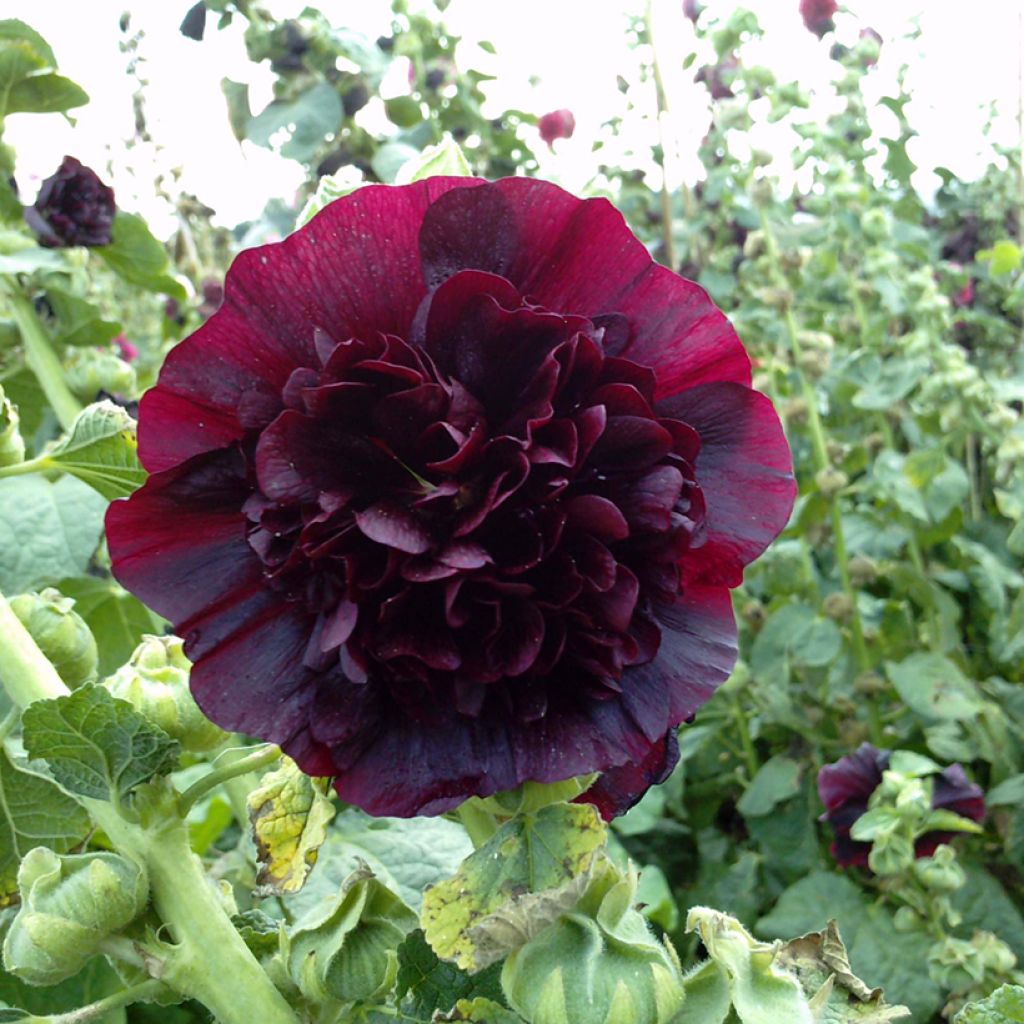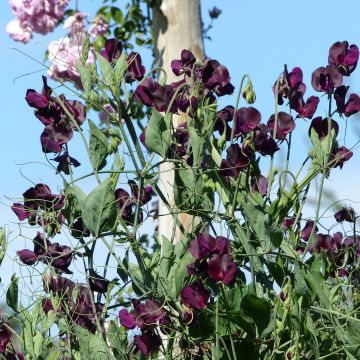

Alcea rosea Chater's Double Maroon seeds - Hollyhock
Alcea rosea Chater's Double Maroon seeds - Hollyhock
Alcea rosea Chater's Double Marroon
Hollyhock
Special offer!
Receive a €20 voucher for any order over €90 (excluding delivery costs, credit notes, and plastic-free options)!
1- Add your favorite plants to your cart.
2- Once you have reached €90, confirm your order (you can even choose the delivery date!).
3- As soon as your order is shipped, you will receive an email containing your voucher code, valid for 3 months (90 days).
Your voucher is unique and can only be used once, for any order with a minimum value of €20, excluding delivery costs.
Can be combined with other current offers, non-divisible and non-refundable.
Home or relay delivery (depending on size and destination)
Schedule delivery date,
and select date in basket
This plant carries a 6 months recovery warranty
More information
We guarantee the quality of our plants for a full growing cycle, and will replace at our expense any plant that fails to recover under normal climatic and planting conditions.
Would this plant suit my garden?
Set up your Plantfit profile →
Description
Alcea rosea 'Chater's Double Maroon' is a majestic hollyhock with very double flowers, in maroon with dark garnet highlights. They succeed each other throughout the summer on giant floral spikes, attracting many pollinating insects such as bees and butterflies. They are susceptible to wind so will benefit from the shelter of a wall or hedge. More biennial than perennial, this variety self-seeds spontaneously. A great classic for cottage or countryside gardens!
Alcea rosea, the hollyhock, belongs to the Malvaceae family. It is a species native to Asia Minor, notably Turkey and Palestine. This plant has long been cultivated and even naturalised in Western Europe. The 'Chater's Double Maroon' variety is part of the 'Chater's' series, selected in the UK by Thomas Chater in the 19th century. The 'Chater's' are characterised by very double flowers, full of satin petals, in various colours. The 'Maroon' cultivar produces floral spikes that can reach between 1.80 m and 2.50 m in height. They are adorned with numerous flowers with tight and crumpled petals, giving them a charming pom-pom collar appearance. The flowers, measuring 8 to 10 cm in diameter, have a very rich colour, mixing brown, burgundy and garnet highlights. This flowering appears in the second year, starting in June-July and continuing until August, with the flowers opening successively from the bottom to the top of the spike. After flowering, the plant produces dry fruits filled with seeds that naturally self-seed, in conditions that suit it, such as wall crevices or rocky soils. The light green foliage is composed of lobed and rounded leaves gathered in a tuft at the base of the plant. It is semi-evergreen.
The 'Chater's Double Maroon' hollyhock is perfect in rural settings and large "English-style" borders. Its dark brown-red colour pairs well with pastel pink tones, but also with warm colours like red, purple, or green. Pair it with Alcea rosea Chater's Double Salmon or 'Mars Magic' for example. Add some bronze fennel to bring lightness to your composition. Common lady's mantle can create a charming anise green mossy carpet at the base of other plants.
Flowering
Foliage
Plant habit
Botanical data
Alcea
rosea
Chater's Double Marroon
Malvaceae
Hollyhock
Cultivar or hybrid
Other Hollyhock seeds
View all →Planting and care
Sow 'Chater's Maroon' Hollyhocks from May to July. It takes 15 to 20 days for the shoots to appear. Transplant the young plants, when they reach a height of 7 cm, at a distance of 20 cm from each other. The following spring, place them in your flower beds at a distance of 40 to 50 cm. Be prepared to stake them if the location is not sheltered from the wind. Avoid planting Hollyhocks in the same spot for several years in a row to prevent the appearance of rust (a parasitic fungus visible as orange powder) on the foliage.
Sowing period
Intended location
Planting & care advice
This item has not been reviewed yet - be the first to leave a review about it.
Similar products
Haven't found what you were looking for?
Hardiness is the lowest winter temperature a plant can endure without suffering serious damage or even dying. However, hardiness is affected by location (a sheltered area, such as a patio), protection (winter cover) and soil type (hardiness is improved by well-drained soil).

Photo Sharing Terms & Conditions
In order to encourage gardeners to interact and share their experiences, Promesse de fleurs offers various media enabling content to be uploaded onto its Site - in particular via the ‘Photo sharing’ module.
The User agrees to refrain from:
- Posting any content that is illegal, prejudicial, insulting, racist, inciteful to hatred, revisionist, contrary to public decency, that infringes on privacy or on the privacy rights of third parties, in particular the publicity rights of persons and goods, intellectual property rights, or the right to privacy.
- Submitting content on behalf of a third party;
- Impersonate the identity of a third party and/or publish any personal information about a third party;
In general, the User undertakes to refrain from any unethical behaviour.
All Content (in particular text, comments, files, images, photos, videos, creative works, etc.), which may be subject to property or intellectual property rights, image or other private rights, shall remain the property of the User, subject to the limited rights granted by the terms of the licence granted by Promesse de fleurs as stated below. Users are at liberty to publish or not to publish such Content on the Site, notably via the ‘Photo Sharing’ facility, and accept that this Content shall be made public and freely accessible, notably on the Internet.
Users further acknowledge, undertake to have ,and guarantee that they hold all necessary rights and permissions to publish such material on the Site, in particular with regard to the legislation in force pertaining to any privacy, property, intellectual property, image, or contractual rights, or rights of any other nature. By publishing such Content on the Site, Users acknowledge accepting full liability as publishers of the Content within the meaning of the law, and grant Promesse de fleurs, free of charge, an inclusive, worldwide licence for the said Content for the entire duration of its publication, including all reproduction, representation, up/downloading, displaying, performing, transmission, and storage rights.
Users also grant permission for their name to be linked to the Content and accept that this link may not always be made available.
By engaging in posting material, Users consent to their Content becoming automatically accessible on the Internet, in particular on other sites and/or blogs and/or web pages of the Promesse de fleurs site, including in particular social pages and the Promesse de fleurs catalogue.
Users may secure the removal of entrusted content free of charge by issuing a simple request via our contact form.
The flowering period indicated on our website applies to countries and regions located in USDA zone 8 (France, the United Kingdom, Ireland, the Netherlands, etc.)
It will vary according to where you live:
- In zones 9 to 10 (Italy, Spain, Greece, etc.), flowering will occur about 2 to 4 weeks earlier.
- In zones 6 to 7 (Germany, Poland, Slovenia, and lower mountainous regions), flowering will be delayed by 2 to 3 weeks.
- In zone 5 (Central Europe, Scandinavia), blooming will be delayed by 3 to 5 weeks.
In temperate climates, pruning of spring-flowering shrubs (forsythia, spireas, etc.) should be done just after flowering.
Pruning of summer-flowering shrubs (Indian Lilac, Perovskia, etc.) can be done in winter or spring.
In cold regions as well as with frost-sensitive plants, avoid pruning too early when severe frosts may still occur.
The planting period indicated on our website applies to countries and regions located in USDA zone 8 (France, United Kingdom, Ireland, Netherlands).
It will vary according to where you live:
- In Mediterranean zones (Marseille, Madrid, Milan, etc.), autumn and winter are the best planting periods.
- In continental zones (Strasbourg, Munich, Vienna, etc.), delay planting by 2 to 3 weeks in spring and bring it forward by 2 to 4 weeks in autumn.
- In mountainous regions (the Alps, Pyrenees, Carpathians, etc.), it is best to plant in late spring (May-June) or late summer (August-September).
The harvesting period indicated on our website applies to countries and regions in USDA zone 8 (France, England, Ireland, the Netherlands).
In colder areas (Scandinavia, Poland, Austria...) fruit and vegetable harvests are likely to be delayed by 3-4 weeks.
In warmer areas (Italy, Spain, Greece, etc.), harvesting will probably take place earlier, depending on weather conditions.
The sowing periods indicated on our website apply to countries and regions within USDA Zone 8 (France, UK, Ireland, Netherlands).
In colder areas (Scandinavia, Poland, Austria...), delay any outdoor sowing by 3-4 weeks, or sow under glass.
In warmer climes (Italy, Spain, Greece, etc.), bring outdoor sowing forward by a few weeks.




























































